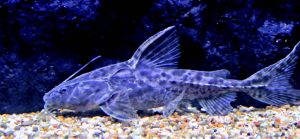Catfishes from the Doradidae family are known as the Thorny Catfishes, owing to the bony lumps that form thorny scutes along the lateral lines . Sometimes, they are also referred to as the Talking Catfishes, owing to the sound they make when they are caught. They can produce sound by moving their pectoral spine or vibrating their swim bladder.
Doradids have three pairs of whiskers compared to the usual four pairs in most catfishes and an adipose fin not present in some catfishes. They are endemic to South America and often exported to the Philippines. In the country, the more popular ones are the small 5-inch Striped Raphael Catfish (Platydoras armatulus) and the gigantic Ripsaw Catfish (Oxydoras niger), which reaches five feet in the wild.
Somewhere in the middle of the size range for Doradids is a thorny fat cat, the Granulated Catfish (Pterodoras granulosus). In the Philippine fishkeeping circles, the P. granulosus is also known by its Brazilian name of Bacu.
Only the Thorn Among Catfishes
The P. granulosus was first described by French zoologist Achille Valenciennes in 1821. His scientific study on the P. granulosus is sometimes shared with German naturalist and explorer Alexander von Humboldt because both worked together in many projects in the 1800s.
The etymology of Pterodoras comes from the Greek words pteron, meaning fin, and doras, meaning skin, in reference to its forked caudal fin. Granulosus is named after the nature of skin: “with granules.”
It hails from South America and is found in the Paraná and Amazon basin, as well as the coastal drainages of Suriname and Guyana. It is widespread throughout most of the larger river systems of South America.
“Monster Fish”
The P. granulosus attains a very modest size of 28 inches (70 centimeters) and weighs about 14 pounds (6.5 kilograms). Because of the size it attains in the wild it, is considered a food fish and is often seen in fish markets. For the fishkeeper, this makes it an ideal monster fish worthy of being collected.
It has a rather big and bony head with small eyes set high on its head. It has three pairs of whiskers since the nasal whiskers are absent. There are no scales, but the skin is thick and tough and there are 25 to 30 thorny scutes along the lateral line on its sides, making it look like a prehistoric monster. Just before its forked caudal fin is a small and fleshy adipose fin.
Its color varies with age. Juveniles are generally brown to dark grey in color with lots of dark spots distributed throughout the body and fins. Adults lose this dotted pattern and acquire a uniform tone of olive green to dark grey.
There is no obvious external sexual dimorphism between the genders but it may be assumed that adults that are more heavily built or robust are females and the relatively slender ones are males. This may not be a reliable distinct feature to determine the sex since P. granulosus in general is wide bodied. There are also no known documentation of the fish ever been bred in captivity.
Aquarium Tips
Keeping the P. granulosus in the aquarium is not a complicated matter. I feel that the only concern when keeping it is its size. Since it reaches 28 inches, it is a rather large catfish and everything else will have to be large. It will require a large tank. I believe for a catfish this big, a 200-gallon tank should be the minimum and anything bigger is better. Your large tank should be outfitted with a large filter system equipped with enough filter media and run by a pump with adequate flowrate. With such a set-up, your tank should be supported with weekly water change of about 30 to 40% to keep the water in optimum quality.
But that’s about the only difficult thing you will encounter with the P. granulosus. Everything else will come easy, maybe except for the fact that since it’s such a big fish, it has a matching appetite and thus feeding will require a big budget.
The easy part is that it is such an easy fish to feed since it is never choosy and will eat plant- or animal-based food. A true omnivore, it takes live or fresh food like shrimp, earthworms, mussels, squid, and fish and will gladly eat prepared commercial fish food. They will even munch on fruits and veggies. So long as it food fills up its big belly, it will never say no to food!
The P. granulosus doed not need extreme water parameters. It is perfectly fine with pH we normally have in our homes. A pH range of 6.4 to 7.6 is best for it. General hardness of slightly hard to hard is also good. Water temperature of 22°C to 29°C should also work well.
It is such a gentle giant that it generally poses no danger to any other tank inhabitants. It is never aggressive towards other fish, except those too small and are seen as food. They are good tank mates with other large catfishes, characins, cichlids, and other monster fishes.
Timid most of the daylight hours, it prefers to stay motionless at the bottom or partly hidden next to a large piece of wood, stone, or other décor. It is a nocturnal fish and will therefore be more active at night. It would be good to consider using subdued lighting rather than one with strong bright light.
P. granulosus catfishes are available in the country. They are now seen in some shops with more regularity than ten years ago. Stocks are not abundant and may be seasonal at best, but they are nevertheless available. Fishkeepers should take advantage of this because we will never know how long they’ll be in stock. Believe me, you will never regret having one because the P. glandulous is one gentle cat that is so easy to keep.
This appeared in Animal Scene magazine’s August 2018 issue.






